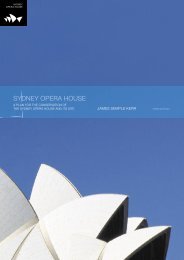Annual Report 2011 - Sydney Opera House
Annual Report 2011 - Sydney Opera House
Annual Report 2011 - Sydney Opera House
You also want an ePaper? Increase the reach of your titles
YUMPU automatically turns print PDFs into web optimized ePapers that Google loves.
79(x) InventoriesInventories held for distribution arestated at cost, adjusted when applicablefor any loss of service potential. A lossof service potential is identified andmeasured based on the existence of acurrent replacement cost that is lowerthan the carrying amount. Cost isassigned to individual items of inventoryusing the weighted average cost method.(xi) InvestmentsInvestments are initially recognised atfair value plus, in the case of investmentsnot at fair value and the carryingexpenses are recorded on the profitor loss through transaction costs.The Trust determines the classificationof its financial assets after initialrecognition and, when allowed andappropriate, re-evaluates this at eachfinancial year end.Fair value through profit or loss - TheTrust subsequently measures investmentsclassified as “held for trading” ordesignated upon initial recognition “atfair value through profit or loss” at fairvalue. Financial assets are classified as“held for trading” if they are acquired forthe purpose of selling in the near term.The Hour-Glass Investment Facilities(other than the Hour Glass Cash facility)are designated at fair value throughprofit or loss using the second leg of thefair value option – i.e. these financialassets are managed and their performanceis evaluated on a fair value basis, inaccordance with a documented riskmanagement strategy, and informationabout these assets is provided internallyon that basis to the Trust’s keymanagement personnel.Any Hour Glass Investment facilities heldby the Trust are short term unit trustinvestment funds managed by the NSWTreasury Corporation. The agency hasbeen issued with a number of units inTCorp’s Hour Glass Cash Facility Trust,based on the amount of the deposit andthe unit value for the day.Held to maturity investments – Nonderivativefinancial assets with fixedor determinable payments and fixedmaturity that the agency has the positiveintention and ability to hold to maturityare classified as “held to maturity”. Theseinvestments are measured at amortisedcost using the effective interest method.Changes are recognised in the incomestatement when impaired, derecognisedor though the amortisation process.Available for sale investments - Anyresidual investments that do not fallinto any other category are accountedfor as available for sale investments andmeasured at fair value directly in equityuntil disposed or impaired, at which timethe cumulative gain or loss previouslyrecognised in equity is recognised inthe income statement. However, interestcalculated using the effective interestmethod and dividends are recognised inthe income statement.Purchases or sales of investments undercontract that require delivery of the assetwithin the timeframe established byconvention or regulation are recognisedon the trade date; i.e. the date the entitycommits to purchase or sell the asset.The fair value of investments that aretraded at fair value in an active market isdetermined by reference to quoted currentbid prices at the close of business on thebalance sheet date.(xii) Impairment of financial assetsAll financial assets, except thosemeasured at fair value through profit andloss, are subject to an annual review forimpairment. An allowance for impairmentis established when there is objectiveevidence that the entity will not be ableto collect all amounts due.For financial assets carried at amortisedcost, the amount of the allowance isthe difference between the asset’scarrying amount and the present value ofestimated future cash flows, discountedat the effective interest rate. The amountof the impairment loss is recognised inthe income statement. When an availablefor sale financial asset is impaired, theamount of the cumulative loss is removedfrom equity and recognised in the incomestatement, based on the differencebetween the acquisition cost (net of anyprincipal repayment and amortisation)and current fair value, less anyimpairment loss previously recognisedin the income statement.Any reversals of impairment losses arereversed through the income statement,where there is objective evidence, exceptreversals of impairment losses on aninvestment in an equity instrumentclassified as “available for sale” mustbe made through the reserve. Reversalsof impairment losses of financial assetscarried at amortised cost cannot result ina carrying amount that exceeds what thecarrying amount would have beenhad there not been an impairment loss.(xiii) Derecognition of financial assets andfinancial liabilitiesA financial asset is derecognised whenthe contractual rights to the cash flowsfrom the financial assets expire; or if theagency transfers the financial asset:- where substantially all the risks andrewards have been transferred; or- where the agency has not transferredsubstantially all the risks and rewards,if the entity has not retained control.Where the agency has neithertransferred nor retained substantiallyall the risks and rewards or transferredcontrol, the asset is recognised tothe extent of the agency’s continuinginvolvement in the asset.A financial liability is derecognised whenthe obligation specified in the contract isdischarged or cancelled or expires.(xiv) Derivative Financial InstrumentsThe Trust holds derivative financialinstruments to hedge its foreign currencyrisk exposures. Derivatives are initiallyrecognised at fair value; attributabletransaction costs are recognised in theprofit or loss when incurred. Subsequentto initial recognition, derivatives aremeasured at fair value and changestherein are accounted for as below.Changes in the fair value of the derivativehedging instrument designated as a cashflow hedge are recognised directly inequity to the extent that the hedge iseffective. To the extent that the hedgeis ineffective, changes in fair value arerecognised in profit or loss.If the hedge instrument no longermeets the criteria for hedge accounting,expires, or is sold, terminated orexercised, then hedge accountingis discontinued prospectively. Thecumulative gain or loss previouslyrecognised in equity remains thereuntil the forecast transaction occurs.(xv) Other AssetsOther assets are recognised ona cost basis.

















